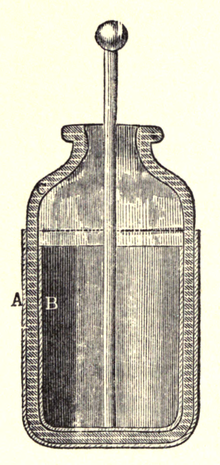Leyden jar

Cross section of a Leyden jar. A and B are metal foils.
The Leyden jar is the simplest and earliest form of capacitor, a device for storing electric charge. It is named after the city of Leyden (or Leiden), where, in 1745 at the university, it's properties were discovered by by Pieter van Musschenbroek. About the same time, possibly a month or two, the same device was discovered independently by the German cleric Ewald Georg von Kleist.
Typically, a Leyden jar comprises a glass jar coated inside and outside with unconnected metal foils, and a conducting rod which passes through the jar's insulated stopper to connect with the inner foil. Effectively, then, there are two conductors, the one almost completely enclosed by the other, and separated from it by the thickness of the dielectric (the glass). If either conductor is connected to earth, and the other insulated and charged (usually from an electrostatic generator), an opposite and nearly equal charge is induced in the former.
Leyden jars were used to carry out many early experiments in electricity but are now little used outside the classroom.


